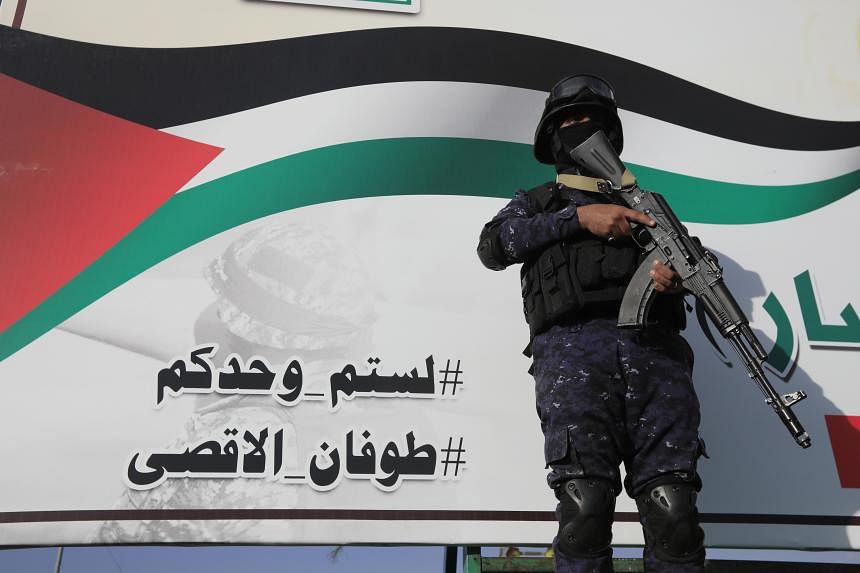WASHINGTON – The United States and its allies have weighed striking Yemen’s Houthi militants after telling them to either halt their attacks on ships in the Red Sea or face unspecified action.

Washington and a dozen nations this week warned that the Houthis would “bear the responsibility of the consequences” if they persisted with their attacks in the crucial maritime trade artery.
Several military and naval experts interviewed by Bloomberg have interpreted this as a threat of imminent strikes against the group, though such a move runs the risk of making matters worse, so more limited action is also a possibility.
Challenges include the potential for further regional instability, with tensions already high due to Israel’s war against Hamas.
US President Joe Biden must also consider the effect of conflict during an election year.
The US may also rely on diplomacy, with Mr Biden’s special envoy for Yemen, Mr Tim Lenderking, travelling to the Middle East next week to join Secretary of State Antony Blinken on his tour.
Mr Lenderking said while there is “no tolerance” for the ship attacks that have created “a climate of alarm” globally, the Houthis still have a chance to opt for the “wisest course” of ending violence in the Red Sea and focusing on the needs of Yemeni people. He spoke to Qatar-based Al-Jazeera news channel on Jan 5.
If diplomacy fails, the US and its allies will have to carefully “choose options that are clearly defensible” and which target the Houthis’ ability to continue disrupting Red Sea navigation while “avoiding getting involved in a regional conflict”, said Mr Nick Childs, senior fellow for naval forces and maritime security at the International Institute for Strategic Studies (IISS).
According to more than a dozen people interviewed by Bloomberg including experts on Yemen, shipping and defence as well as security, these options include:
Targeted strikes
These would be focused on eliminating or degrading the Houthis’ ability to fire ballistic missiles at ships and shipping lanes by striking launch sites, radars, missile warehouses and other supporting infrastructure and logistics.
Since mid-November, the Houthis have fired more than 100 drones and ballistic missiles in two dozen separate attacks, according to the Pentagon. More than 15 vessels have been targeted.
Yet this approach leaves the Houthis with other means like drones, sea mines and attack speedboats, while running the risk of escalating the situation further – stepping up the battle with Yemeni militants that could draw in their Iranian backers.
“What we have yearned for from day one is for the war to be directly between us and the American and Israeli” enemy, said Houthi leader Abdul-Malik Al-Houthi in a speech in December.
Major offensive
Most Yemeni factions that have been fighting the Houthis since they captured the capital Sanaa nearly a decade ago, alongside some regional backers such as the United Arab Emirates (UAE), favour strong retaliation. That includes redesignating the Houthis as terrorists, targeting their finances and launching broader military action if necessary.
Some say ousting the Houthis from the port city of Al-Hudaydah is the only way to restore calm to the Red Sea.
Many blame the Houthis’ coastal presence on the pressure exerted by the US and other Western powers on anti-Houthi forces, as well as Saudi Arabia and the UAE, to halt a major offensive in 2018 to recapture Al-Hudaydah on humanitarian grounds.
“The terroristic Houthi belligerence is the natural result of the international community’s abandonment of its responsibilities in bolstering the defensive capabilities of the Yemeni government,” said the Presidential Leadership Council (PLC), which represents the internationally recognised government.
Any major military action against the Houthis will have to involve the PLC’s two main regional backers, Saudi Arabia and the UAE. Right now both, and especially Riyadh, have no desire to rekindle a conflict they have been doing everything to extinguish.
Ship escorts
Another option would be to significantly expand the mandate of Operation Prosperity Guardian – a US-led military operation set up in December – to include the escort of ships in the area between the Gulf of Aden and the Red Sea’s southern section, akin to what Nato did 15 years ago at the height of the Somali pirate crisis.
But unlike Somali pirates, Houthis have significant military resources and the area they menace is relatively vast, so this would require numerous warships with advanced air defence systems.
Many countries, particularly regional Arab ones, are reluctant to join, given Houthi claims that their attacks are in solidarity with Palestinians in Gaza, according to Mr Childs of the IISS.
The logistics are daunting too. There are on average about 250 vessels transiting the Red Sea at any given moment; shipping companies will have to do significant planning and coordination to get into escort convoys, said Mr Ami Daniel, chief executive of Winward, a maritime artificial intelligence company.
Appeasement
The US and its allies could follow the example of Saudi Arabia, which has worked hard to cajole the Houthis into committing to a permanent ceasefire and a United Nations-overseen peace plan by offering financial incentives.
The problem is that Houthi actions in the Red Sea have exposed the severe limitations of “the concept of stability” that the Saudis have sought to forge with the group, said Mr Majed Almadhaji, director of the Sanaa Centre for Strategic Studies.
And unlike Saudi Arabia, a superpower like the US has other considerations.
Houthi attacks have been “somewhat of a blow to the US-led order of maintaining open seas that’s been around for decades”, said Mr Torbjorn Soltvedt, principal Middle East and North Africa analyst at London-based Verisk Maplecroft. BLOOMBERG




